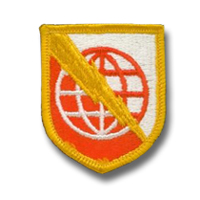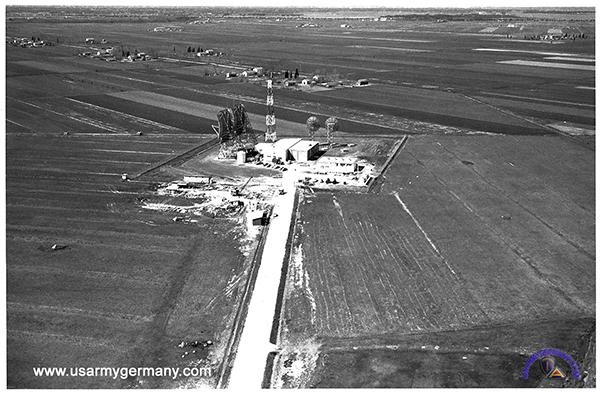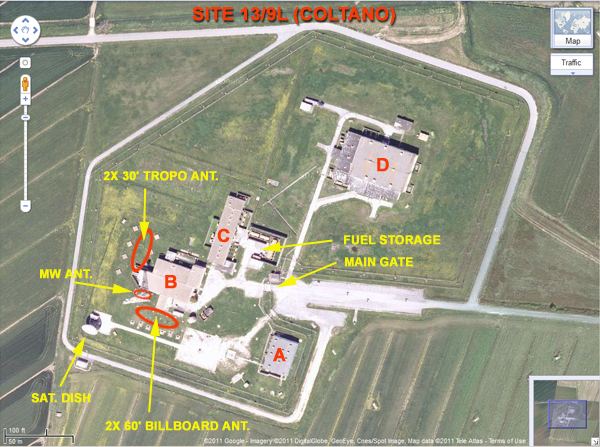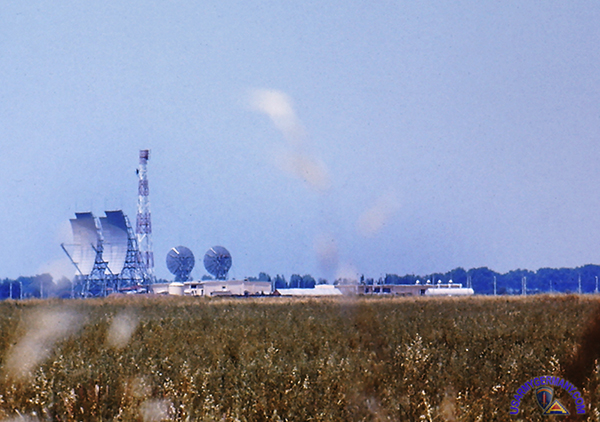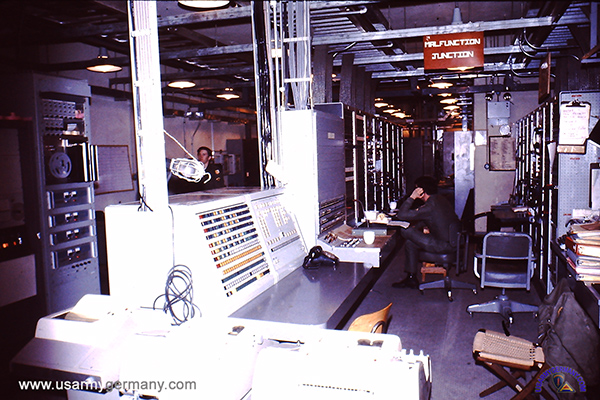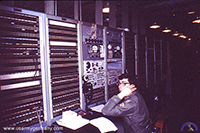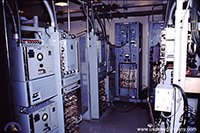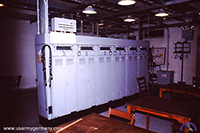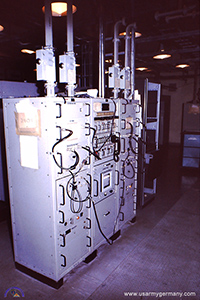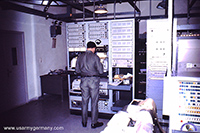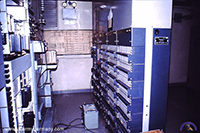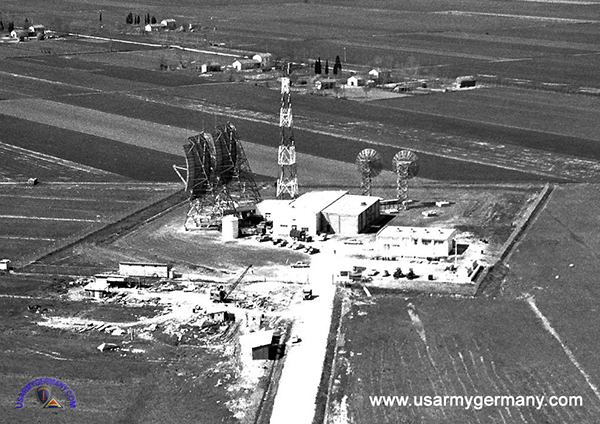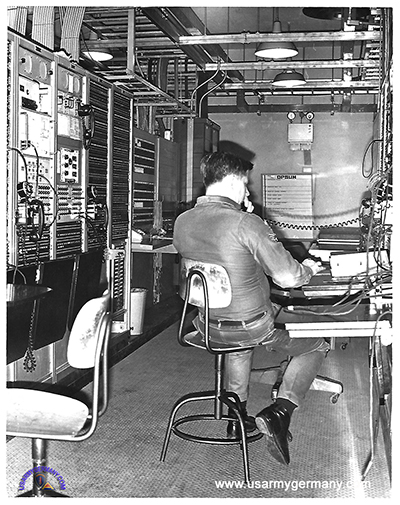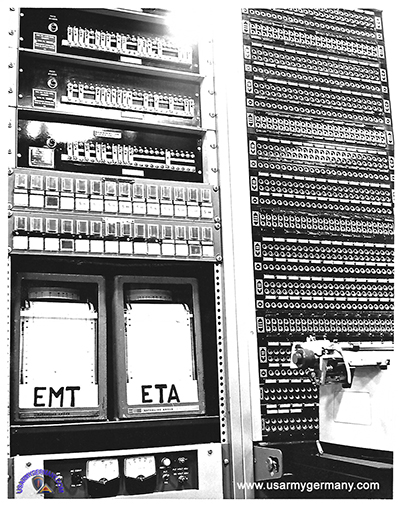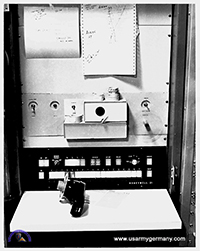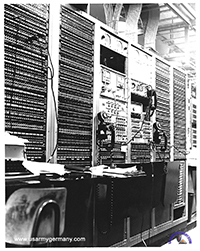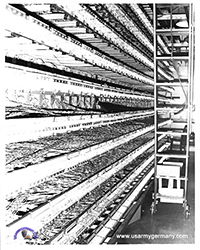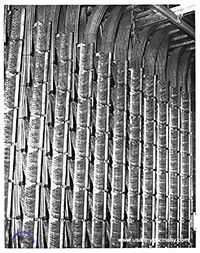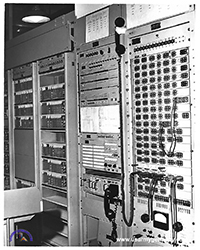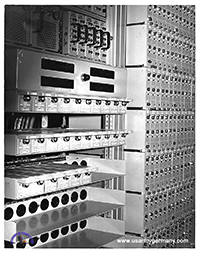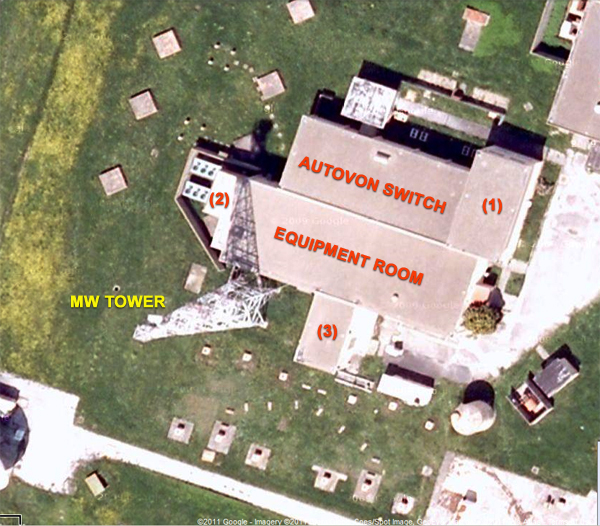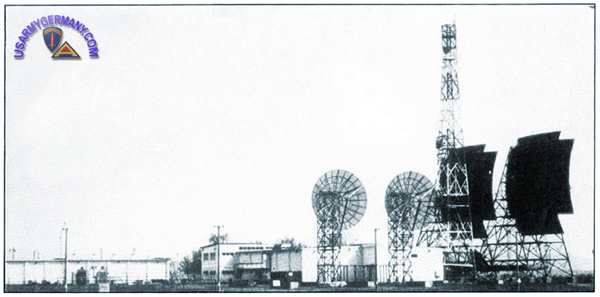| If you do
NOT see the Table of Contents frame to the left of this page, then
Click here to open 'USArmyGermany' frameset |
||||||||||||
Coltano Signal Station |
||||||||||||
|
|
||||||||||||
|
||||||||||||
|
|
||||||||||||
| Coltano Signal Station | ||||||||||||
 Coltano Signal Station - Site 13/9L, c. 1970 (Robert Harris) |
||||||||||||
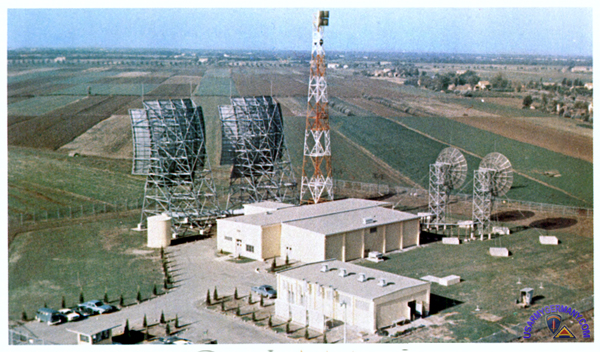 Aerial view of Coltano Signal Station, probably 1960s |
||||||||||||
| (Source: Official 509th Signal Battalion website - http://www.509sigbn.army.mil/) | ||||||||||||
| COLTANO HISTORY I also read on the official Camp Darby history site about the POW camps. I had wondered where those were located. I figured they'd be in the same general area around Pisa but didn't realize they were at Coltano. |
||||||||||||
| If you have more information on the history or organization of the 509th Signal Battalion, please contact the webmaster (email address at top of page). | ||||||||||||
|
|
||||||||||||
| 1967 | ||||||||||||
| (Source: Email from Larry Tallman, 32nd Signal detachment, 1967-69) | ||||||||||||
| I saw your Webpage about Coltano and the Comm. Center. I was interesting taking that trip down memory lane. I was stationed there from 1967 – 1969. Worked Tech Control at the Coltano site and at the time there was a communications site in the warehouse area of Darby and another on top of a warehouse for headquarters. The com center/tech control in the warehouse area was very small. It was located in the same building and provided communications for the crypto center. That signal was microwaved to Coltano. As I remember, the tower was right next to the com center. The Army ASA group, when they were around, always had their monitoring truck parked under that tower. If there was any sort of antenna for the HF site between Darby and Tirrenia. I don’t think it was visible from the road. There was a microwave antenna out at Coltano and it handled the shot North to Germany but I thought it went through a remote facility on a mountain in Italy. The group there was very small and when trouble developed on that link we could never get a hold of anyone because, as were told, they were probably in the parking lot playing basketball. We had to use the land line to talk to them because they didn’t break out any of the signals so they didn’t have a voice order wire. They just re-transmitted the baseband as it was. The next stop for that microwave link was at the Zugspitze in Germany. It was an Air Force facility on a mountain top that wasn’t manned after sunset because of the hazardous conditions in the dark. When we lost that link we just waited until morning until the facility was manned again. The most fun was working out at Coltano. I worked for a civilian, named Toyota, who was installing a computer to monitor the communications channels and write outage reports. All in all it was an interesting assignment. The AUTOVON building had just been built and hadn’t gone active when I was there. One evening when we were leaving to head back to the base we could hear the MP’s yelling over at the AUTOVON facility. They had their own security at the time. It seems one of the guards had been playing with is pistol and had dropped and lost a cartridge. They had all the MP’s in the place crawling around on their hands and knees looking for the bullet. Don’t know if they ever found it. Another interesting story about Darby. When I first arrived there was an old long wave communication site down closer to the base off the road to Tirrenia. They were in the process of closing the facility when I got there so I never got out to see it. They had the site grunts dissemble the station and crate it up and get it ready for shipment back to the states. That task was accomplished. Not long after the last crate was sent down to the pier in Livorno, Washington called and wanted them to reestablish the site and get it back on the air. They accomplished that task also. Shortly after it was done Washington decided that they really didn’t need the site after all. Darby was instructed to take it all apart again. This time when they removed the cables from the equipment instead of using the intended connectors they used fire axes and chopped the cables up. Just as sure as the sun will come up tomorrow once all that equipment had been sent down to the pier again some in Washington came up with an idea for the sites reuse. When they were informed that new cabling would have to be supplied, Washington forgot the idea. We both missed most of the fun at Darby. When France kicked NATO out some of the people that were deployed to Darby were “Beatniks” in US Army uniforms. They had protest marches and all sorts of odd behavior at the base. I got there at the tail end of that and had to deal with a lot of crazy drunks. It really was an interesting time back then. |
||||||||||||
| If you can provide any details on the equipment shown in the photos below, please contact the webmaster (email address at top of page). | ||||||||||||
|
||||||||||||
| COMMENTS ON PHOTOS: (Source: Redick D. Hatfield)
|
||||||||||||
| (Source: Email from Don Salmon) | ||||||||||||
| I was stationed with in the Microwave Tropo Company at Coltano between August of 1967 and April of 1969. I was trained on and assigned to the Console Remote Equipment which was the army's first piece of digital switching equipment. I volunteered for the Regular Army in May of 1966 (yikes, almost 50 years!). I was interested in electronics, and it was very early in the computer age. I found the 34D20 MOS (Automatic Data Processing System Repairman) which was a 36-week course at Fort Monmouth. The Army was starting to use computers for various functions, and the early ones required a lot of service. They were transistor operated (no tubes!), but they were full sized transistors and the boards were still huge. I graduated from the course nine months later with an automatic promotion to Spec. 4 (E4) and awaited orders which I assumed would be to Vietnam. Four guys from my class, including me, were, instead, being sent to Italy, much to the relief of my parents. After waiting months for a security clearance, I was assigned to the Coltano Signal Station which was an amazing facility. I still tell people about the giant billboard antennas which, because of the photos on your great site, I can actually show them. The Console Remote Equipment (CRE) was, as I recall, part of the first digitally operated switching system the Army bought (hence the need for a 34D20). It was connected to 7 or 8 tributary sites which, we were told, were nuclear missile facilities. The CRE training was done at an Army facility in Mannheim, but I do not recall the name. I believe it was part of STRATCOM-Europe, perhaps in Funari Barracks. At the Coltano signal site, the CRE was located in the larger of the two rectangular buildings in back of and closest to the billboards. You can see the entry door off of the parking lot. The equipment was in the rear of the building directly behind Tech Control. I do not know the name of the section, but it was in the same area as shown in Larry Tallman's interior photos. The Company size unit we were part of was called Microwave Tropo Company led, at the time, by Capt. John E. Rickert. We worked 8 hour, rotating shifts at Coltano. My boss was a Spec. 7 (E7) which designation doesn't exist anymore. The CRE was so reliable, I barely recall having to service it. We had more problems with the lines coming in and out which kept the Tech Controllers and Radio Repairmen busy. We shared the facility with the Air Force which was responsible for the lines going south and east as far as Incirlik Air Base in Turkey, while the Army handled the lines going north of Coltano toward Headquarters in Germany. I was honorably discharged in April of 1969. I completed college on the G.I. Bill, and spent my entire career in the mortgage business (still working). I'm married with two children and four grandchildren. I still think something about my Army service almost every day. Thanks so much for your help and for this great site that brings back many good memories. |
||||||||||||
| (Source: Email from Larry Jackson) | ||||||||||||
| I saw where you wanted input and reminiscences of people who worked at Coltano, Italy in the late 1960s.
I was in the US Army at Coltano, July 1967 - Sept 1969. Living at Camp Darby, working at Coltano. Long time ago. I was a microwave radio equipment repairman, fancy name for a floor washer or whatever. I remember one time they wanted me to work in the power plant. There were all Italian nationals working there. The power came in on big bus bar. I still remember...30,000 volts at 34,000 amperes. They told me it was enough to power the city of Pisa. When I finished I was SP/4, but training SP/5 people who got that rank directly out of school. The school was at Ft. Monmouth, NJ. I used my time there for other purposes, and saw: Italy, Switzerland, Greece, Germany, Lichtenstein, Monaco, France, Israel, and Austria. The Army was generous in making available much sightseeing. We would go up to Berchtesgaden, Germany for religious conferences many times - one time going to one denomination conference, another time to a different group. Lots of great sightseeing there. I had a personal friend who was the primary person on Radio Monaco, so saw his stuff there. The radio station in the mountains above Monaco was built by Hitler, and the radio tubes were water cooled. My military close friend, Rocky Roman [from Puerto Rico], and I went to Elba, the island where Napoleon was exiled. Great trip! Wish I could get in contact him again! Back in those days we also had microwave bases in Iran and Libya. One thing not noted elsewhere is that from Coltano we shot over [microwave] to the island of Sardinia. From there I think they shot over to islands owned by Spain. Since I worked at Coltano at the time of the photos on this page, it is possible that I was in some of those photos. I remember they told me of a workman working on the tower died when power accidently was on. Birds who flew there would explode, so I was told. outside the coltano buildings there were the original concrete slabs from marconi. the local farmer had a ram he would pasture on the property. i fed it bread and it would butt me. At coltano there were two constant hums, one at 1k and the other at 4k. One time driving back to Darby from Coltano at 3 am, I totalled the "carryall" [I think that is what it was called] going over the RR bridge. I flew 75 feet through the air and landed on the roof. The vehicle was totalled. Another time I was assigned to wash the floor inside the transmitter. So, I flipped the circuit breaker [to stay alive] while I cleaned it. Then flipped the circuit breaker back on but nothing happened. They had all kinds of upper rank people to try to figure it out...because of lack of use, the circuit breaker was bad, had corroded. One guy who must have hated it there, did sabotage just before he got out. He went into the control room, and bent the needle on the thermometer, so everything would overheat. Sometimes at night at Coltano the four of us would play a long card game. Bruno and Jim Davis and me and one other. I never played that game again. Bidding and melding and such. One time I ate at the Italian army mess hall at Darby. Tripe and vino, as I recall. I hated the revolving shifts, except we hardly ever had inspections. They never could figure out if we were supposed to be sleeping or working or on 3 day pass. One time at Coltano the water purifier did not work and I got sick. They had a sample in a jar of a grass snake - poisonous, but it looked like a blade of grass. I remember the huge diesel generators with huge flywheels. They were held in reserve if power went out. As I recall, six generators, 50 hz. I remember finding a piece of wood painted white in the mashed potatoes, and another time finding a piece of plastic bag in the strawberries. You had to be careful at the mess hall. Much memory is lost - it has been over 50 years ago. Hoping some of this is of help to you. A few more memories: Driving between Darby and Coltano, we would drive on the original Appian Way, built by Caesar. It was very close to the Coltano entrance. Also when driving we would need to watch very carefully for the farmers plowing with oxen, when they would appear on the road. Oxen are too slow to get out of the way. The Bruno mentioned earlier is Bruno Suligoj, now living in Gorizia. The locals had guinea hens they would let run wild in the area. But if you hit one on the road.... the Army had to pay for that bird, and all the eggs it would ever lay, and all the chickens those eggs would hatch, and all the eggs they would ever lay, and all the chickens that would hatch from those eggs, etc. A real "golden egg" situation! |
||||||||||||
| (Source: Email from Rick Crosson, son of Earl C. Crosson who served at Coltano, 1967-70) | ||||||||||||
| My Father, the late SGM Early C. Crosson, served at the Coltano site from 1967 to 1970. He was one of the NCOICs of the Microwave Tropo Company. He would have been an E6/E7 at the time. My personal memories of the facility are limited to his stories, particularly the stories about how birds would be incinerated when flying in from of the big billboard Tropo antennas. While most of my memories are of Camp Darby and living in the town of Tirrenia, I do recall my dad taking me out the Coltano site a couple of times. I was in the 4th, 5th, and 6th grade during those wonderful times in Italy. I learned to speak the language, I played on the Little League baseball team, the Orioles. I hit my first over the fence home run at the little league field on Camp Darby. Our All-Star Team played in the final All Italy Little League Series in the summer of 1970. We came in second place out of all of Italy. Had we won, we would have gone to All Europe, and then the Little League World Series. Oh well. I learned to swim, and was baptized in the Mediterranean Sea at the US beach. I also washed cars at the beach for extra money. My fondest memories are of my dad being in charge as an NCO. He was my inspiration for wanting to join the Army and becoming an officer. I used to tell him that someday, he would have to salute me. That day happened for us in June, 1980, when I was commissioned a Second Lieutenant of Infantry/Aviation. My dad, then a Command Sergeant Major (Ret) rendered to me my first salute, and I handed him the silver dollar traditionally given to the first enlisted soldier to salute you. My full reverence for my dad’s military service came into being during those wonderful days in Italy. Your web site has given me greater insight to what his working days and mission were like. What a critical role he had, and what monumental responsibilities that site at Coltano had. This was all pre-digital and pre-satelite communications. They literally skipped signals off the troposphere to speak around the world. I admire and respect all the soldiers, airmen, and civilians who manned the Coltano Site for all those critical years. I remain proud of my dad and his contribution to that noble effort. My dad passed away in January, 2017. We buried him with full military honors at Tahoma National Cemetery, Kent, Washington. While I miss the old Sergeant Major, I know he is somewhere with his old war buddies playing cards and raising hell. Here’s to you, Pops. My time there still holds a special place in my heart. So much of who I am, what I believe, and what I became stemmed from my 3 years living in Italy (1967-1970). I have plans to visit all the places there very soon. |
||||||||||||
| 1968 | ||||||||||||
| (Source: Email from Peter Byrne) | ||||||||||||
| I was stationed at Coltano in 1968-69. I am the SP5 shown in Larry Tallman's pictures (see email above). I found your website some time ago and wanted to share with you but only recently found my stash of Coltano pictures. The aerial photo of the signal station I found while I was at Coltano so I’m guessing it was taken in the early 1960s, pre-Autodin and Autovon. I arrived at Camp Darby in October 1967 and was originally assigned to Headquarters, USASTRATCOM-EUR Signal Group Mediterranean. That organization was responsible for Army Signal assets in Italy, Greece, Turkey, and Iran. As Larry Tallman noted, the HQ was located on the second floor of one of the warehouses belonging to the 8th Logistics Command. My job was to receive daily operational reports from the subordinate commands and consolidate them for the CO. As you can imagine, once that task was completed there was a lot of free time to fill, mostly reading. The attached photo montage shows me in the comm center. In the summer of 1968, I and several other SigGrpMed techs were sent out to Coltano on a familiarization rotation. I was able to finagle a permanent switch with another tech and stayed at Coltano until I was discharged in September 1969. One final, personal note: While we were in Italy, I, Larry Tallman, and a half-dozen other guys had great adventures as a group. Once discharged, though, we lost track. I’ve attached some photos of the interior of Coltano, mostly of the Tech Control area as that was my interest. |
||||||||||||
|
||||||||||||
| 1970 | ||||||||||||
| (Source: Email from Robert Harris) | ||||||||||||
| Looking at the Google Maps image, you have the guard house (main gate) and the AUTODIN building ("D") and the antenna bases labeled correctly.
The actual site name for the link using the 30 ft. dishes was Site 046, located up in the hills above Finale Liguria (not Savona), and from there across Switzerland to Feldberg in the Black Forest (Schwarzwald) in southern Germany. That link gave a lot of problems in the winter because of the distance, the Alps, and the snow. It was tropo but not all that powerful. Let's talk about Building "B" - that was my domain. Look closely and you will see 4 distinct sections to the building. The smallest ("3") being the southernmost housed the heat exchangers for the high power transmitters for the shot to Limbara. These transmitters had water cooled Klystrons... make that the mother of all microwave ovens. The longest section of this "B" building was the equipment area for all the microwave, multiplex, tech control, Console Remote equipment, main distribution frame, supply room, front office. There has been something added to the west end of the building ("2") that wasn't there in 1972. The shorter section of "B" was the AUTOVON switch. That went active while I was there 1969-72. I used to go over there during slack times and patch calls thru to the States for the guys from all over Europe. There is a smaller section ("1") that appears to be taller at the end of the AUTOVON that was not there in 1972. Not a clue about that. I hope this is of some help to you. Oh, when I was there we were USA STRATCOM Signal Group Mediterranean... never heard of the 59th (Sig Co) while I was there. |
||||||||||||
|
||||||||||||
| ADDITIONAL INFORMATION After looking at the picture some more and exercising my rusty old memory, I am not so sure the the heat exchanger area (originally ID as "3") actually was sticking out of the side of the building like that. The front door was in the center of the building and when you entered there was the admin office to the right and rest room to left. Down the hall a bit, Supply was on the right and heat exchanger room to left. I am not so sure now that it actually was a large enough area to protrude that much... that might have been a remod/addition at some later date. After shaking the memories some more I remember that the area where the REL transmitters (Limbara) sat did protrude some from the side of the building, so maybe this was that location but it still seems too big even for that. There are a lot of 1980's and 1990's folks on the Facebook group maybe one of them could shed some light on this area. No idea about the 4 small features outside the front/side of the building or the features next to the north wall of the UTOVON area. The small spots leading to the 046 tower bases were pads for the poles that supported the waveguide runs to the dishes. The spots behind the billboard bases were smaller pads to anchor the antenna support frames. From what I can see you are creating a great site. Thanks so much for asking for my rusty old memories about a place that I enjoyed working at so much. |
||||||||||||
| (Source: Email from Richard Heise) | ||||||||||||
| Just wanted to say hello, I was stationed at Coltano AUTOVON back in 1970-71. Originally trained onsite by civilian contractors and later became senior training technician prior to my rotation state side. Amazing times the things I learned there helped me for the next thirty five years Thirty two of them with AT&T Operations. That building location (ID'ed in photo above as "1") as I remember it housed the diesel on demand generators which were GM Diesels monitoring Italian Commercial Power. At the first sign of failure these were on automatic emergency start. |
||||||||||||
| 1973 | ||||||||||||
| (Source: Email from Redick D. Hatfield) | ||||||||||||
Thanks to all for the trip down memory lane. I was assigned to 13/9L from early 1973 to mid-1976. The Signal Support Agency – Med era. This was my first tour of duty out of AIT. |
||||||||||||
| COLTANO (Site 13/9L) | ||||||||||||
I mention the training because the equipment in the numbered pictures on the webpage (see comments explaining the equipment in the photos above). As for the 5th picture from the top of the webpage, this is a shot of the old Tech Control section in the main equipment room/space. When I got there in ’73 they were in the process of moving it into an old admin or logistics room near the front of the facility. Front and center is the “automated” test and conditioning pilot equipment. As for the picture of 13/9L only main building farther down the page with the labels and numbers. Section 1 was a two story Admin and Logistics Annex that was added in the ’74 to ’75 time frame. Logistics was on the first floor with the admin section to include the offices for the OIC (a Captain) and the NCOIC (a Command Sargent Major). You could see the top of the Leaning Tower of Pisa from the second floor. Can you guess who had the rooms with the views? Section 3 was the room for the REL-2600 equipment for the shots to site 4C. Section 2 was after my time but they look like condensers for HVAC systems. Of note during my tenure, the NCOIC was a CSM with an Italian name on his last active tour of duty. Good guy. He would come through the site around 1 PM bouncing a volley ball saying “everybody outside for PT” (in a heavy Italian accent). We would leave 2 people inside to answer the phones and head out. We would play volley ball, sometimes with 9 people on a side, in the warm Italian sun. Often times we had to quit because the shift change bus with our replacements was coming around the corner. It was rough. On the other hand, during the summer, anybody that was somebody, especially from 5 th Signal Command, would take a government funded trip to “tour and inspect” Camp Darby and the Coltano complex, and then they would sign out on leave. Two weeks later they would sign back in and take the government funded transport home. It seems like every week we were getting ready for an “inspection”. The soldiers that supported the Coltano complex were all based out of Camp Darby, about 9 kilometers away. A shift change bus was provided for the people in the barracks. It ran 3 times a day. Life on Camp Darby while I was there wasn’t too bad. It was a pleasant climate. I spent 3 years there and only saw snow on the ground twice. The nearest town to Camp Darby was Tirrenia which was the southern tip of the Italian Rivera. Lots of tourists in the summer. There was even a designated American Beach in Tirrenia with a PX run concession and USO booth at the beach. And there were some great Italian restaurants in the area, and a lot of history not too far away to include Pisa and Florence. The Rec Services Club on base was one of the best with lots of activities, shows and tours each week. |
||||||||||||
| FINALE LIGURE (Site 046) | ||||||||||||
Let me speak a little about Site 046. I was not assigned there, but people from our unit manned the site. I also made an emergency trip up there in the winter to bring in spare equipment. Site 046 was on a remote mountain top (Google Coordinates. 44.248368, 8.278064) above the coastal town of Finale Ligure and was about 250 kilometers from the nearest US Military facility, Camp Darby. Two plus hours travel time on a good day. It was a radio repeater site where the traffic came in one radio link and out the other. The signal was not broken down to voice or channel level. The site was manned because the radio equipment used, the AN/GRC-66 needed constant maintenance and adjustments. If you checked and adjusted it daily it would work fine. If you went a few days it could get out of adjustment and signal quality would go to …. Remember, this was pre-digital world where everything was analog with tube theory and solid state was in its infancy. There was not a lot of self-correcting circuits in those days. Once you did your daily checks and adjustments, there wasn’t much else to do, except hang around in case something when wrong. The site typically had about 7 to 11 people assigned full time, to include a medic qualified person, most living on the site in the barracks. Living off site was frowned upon. For one reason, the nearest community was about 11 clicks down a winding mountain road. In the winter time the only way on or off the site was with a snow cat! They got that much snow. I seem to remember it was about a 45 minute ride in the cat to the top. And it was real easy to get snowed in. We did for a weekend! During this era there was no such thing as satellite radio, or internet for that matter. Remember we were in Italy in the early ‘70s. The site did not get American Radio or TV. They may have had movie reels delivered, but not enough for a new movie every night. So you had your own collection of records or you listened to Italian radio and TV. One benefit for being assigned there was they got paid separate rations, rations not available. And somehow they had a local, Italian cook or chef to prepare their meals. Once a month they would pool their money, make a run to Camp Darby, get priority treatment in the commissary, and stock up on supplies. Take the supplies back up the hill and the chef would prepare their meals. Not a great weight control program. As for the site layout. If you Google the coordinates above you will find what is left of the compound. Sorry, no pictures. As you come into the compound the small structure on the right is the guard shack. Not sure of the two story structure directly opposite on the left. The large structure on the south side of the site orientated in an east/west direction was the garage for their assigned vehicles to include a van or two, snow cat(s?) and snow mobiles. I think it also housed the generators. The large structure running north/south on the west side of the compound was the barracks to include kitchen and multi-purpose space (dining room, lounge, TV room, etc). The remaining structure in the compound was the radio room. The pads outside it was for the antennas facing Coltano to the south east and Germany (Feldberg) to the north. In the middle of a winter storm on top of a mountain the trip from the barracks to the radio room or generator could be challenging to say the least. Snow tunnels and rope safety guides come to mind. Who wouldn’t want to be assigned there for 2 or 3 years? I can remember in the late spring or early summer, down on Camp Darby were it never snowed, while you were getting ready to go to the beach, you would see a flatbed truck deliver the dirty yellow snow cat to the motor pool for its annual service. It just looked out of place. |
||||||||||||
| 1975 | ||||||||||||
| (Source: Email from Geri Sunderlin, Coltano AUTODIN) | ||||||||||||
| It was 50 years ago, but I joined the Army in the delayed entry program in July 1974 at the age of 19. I made the decision to join the Army as a Sophomore in High School at the age of 16. As a young woman, I wanted to serve our country just like any man could do. I researched it for 3 years then after graduation from Santa Clara High School in 1974, I joined the US Army. After enlisting I had to take a helicopter ride from Oakland, Ca to San Francisco, CA to eventually fly out to Ft. Jackson, SC for Basic Training. My first experience going into a helicopter was quite a thrill. My MOS was 72G - Data Communications Switching Center Specialist. I was one of about 15 WACS that lived in barracks at Campo Darby, Italy. I arrived in March 1975. I was assigned to Coltano in the AUTODIN Center, which was located near an Italian Vineyard. We had to take the Duty Bus to get there each day. We worked rotating shifts, days, swings, and mids. Most of the guys working there had just come out of Vietnam, while others (men and women) were new recruits such as myself. It was fascinating to see the big satellite dishes out behind the AUTODIN and AUTOVON centers with a plaque dedicated to Marconi. Sometimes, when it wasn’t busy, I was able to call home via the AUTOVON center and was patched through Moffett Field NAS in Sunnyvale, CA and from there was a local phone call home. My parents were so happy to hear from me. They did visit me in 1976 in Italy. It was so nice to see them. I had four younger sisters at home at that time; I was their oldest daughter. I loved my job at Coltano. I learned so much. There was no such thing as a semiconductor at that time. It was electro-magnetic and vacuum tube technology. We communicated via Teletype. Ironically, how I met my first husband. I had friends in the crypto section and wanted to learn more about it; even though my area was on the mainframe. They gave me a screwdriver to remove one of the failed vacuum tubes. The power was off in the chassis. However, I did not know anything about capacitance; and boom to the floor I went with a big shock. They all laughed. I have to admit it was pretty funny. The Air Force guys lived upstairs and I dated some of them. Great guys. When off shift we went to the Mediterranean Sea to work on our tan in the summer and in the winter drove my Fiat 1800 4-door sedan (Bella) with the Air Force guys up to the Dolomite Mountains to go snow skiing. During my time in Italy I also saw all the sites in Italy from Florence, Rome, Naples, Venice, etc. I also took about 5,000 pictures and traveled throughout the European countries and to other countries including Turkey and Greece. I had a bicycle and sometimes I rode my bike to downtown Pisa. I went to the train station during the summer to watch all the student tourists with their big suitcases and realized they made a huge mistake and started crying. You can't travel like that in Europe without a backpack. I was raised as a Catholic, so when an opportunity came up to volunteer at a Christmas event for a Catholic orphanage in Italy, not far from Pisa, that was run by Nuns, I felt it was a privilege. We were sponsored by Captain Hildebrand. The best military officer I ever met in my life. I will never forget the faces on those kids. They were so happy to see us. It was a humbling and joyful experience. I also played competitive softball with a team of women stationed in Campo Darby and we competed with all the other Army units throughout Italy. We got approved after a female Colonel who sponsored us. We were so happy!!! I played the short-stop position. My team called me "The Star" because I was always overly confident and seemed to help bring in the win with a home run. We traveled to Vicenza, Naples, and had the championship finals in Augsburg, Germany. We came in 2nd place, but what a thrill! Interestingly, after the military I played competitive softball for fun with all kinds of teams for 35 years straight; sometimes as an extra on an all-men's team because they were short players. I felt I was very lucky to have a great education and terrific experience in the military. With that background I left the Army after 3 years and 2 months, in November 1977, and went home to the Silicon Valley in Santa Clara, California and attended college on the GI Bill. I am considered a Vietnam Era Veteran. From there I worked several jobs in the Santa Clara valley for a few years until I landed a great job at Intel Corporation. Ironically, I installed Wide Area Networks around the world and worked as a project/program manager. I retired there after 32 years. I am now living a dream in NW Montana, retired, happily married (the 2nd time), I have one biological son and two step-daughters and just became a Grandma to a boy from my son and his wife. Life is good. ADDITIONAL INFORMATION BILLETS: All the US Army soldiers lived in the WWII barracks on the post of Camp Darby. Most of the male Army soldiers lived in different barracks in separate buildings closer to the main headquarters on post. Ironically, all the WACS lived in the downstairs barracks on the opposite side of the base. The Air Force guys lived upstairs in our barracks. We weren't supposed to go upstairs, but I spent more time with the Air Force guys than I did with the Army guys especially when off duty. Quite frankly, they were much more fun. In fact they got a big metal drum cut it in half and made a big BBQ grill out of it. We had parties behind the barracks all the time on the weekends. We ate well and had lots of Heineken beer (the good European stuff) to drink. We laughed and just had good ol' American fun. I was one of the few women who hung out with the Air Force guys. Many of the WACS hung out, while off duty, with other WACS. They had more in common I guess with each other. However, I I did spend sometime in the summer playing softball with the other WACs. We did have a blast. Other times, for fun we took the train to Firenze to eat at a Chinese restaurant. There were some single women who lived off post. Some guys who brought their wives also lived off post. MESS HALL: At the AUTODIN Center there was only a medium sized breakroom with a Cappuccino machine for coffee, soda machine and snack machine. There was no mess hall at Coltano. We had to take the duty bus back to Camp Darby to eat lunch at the mess hall. Camp Darby was very small by comparison to other posts. There was a recreation center there were we could get some great tours. A movie theater too. So if you weren't creative or adaptable, it would have been boring. I made the best of it. Took the train everywhere, road my bicycle or drove my car and just got lost in the country and took hundreds of pictures. Had fun at the beach and went skiing every chance we could or played softball. It was a wild adventure. I was so fortunate. Great duty, great location, great fun and great people. |
||||||||||||
| 1986 | ||||||||||||
| (Source: ECHO, Sept 1986) | ||||||||||||
| Marconi haunts Coltano by Larry McCaskill An important site since the beginning of radio communication, the Coltano area in Italy is the hub of the 509th Signal Battalion's far flung strategic communications mission. According to research, the Coltano area was first utilized as a signal site by Guglielmo Marconi, the pioneering communicator, in the early 1900s. After numerous successful experiments in the wireless radio field in England, Marconi was able to convince the Italian Minister of Telegraph and Post Office to construct a radio station in the Coltano area. After surveying different areas, Marconi decided on Coltano because of its location, the surrounding terrain and its ability to easily receive and transmit radio signals. With his radio antennas and nets firmly in place, Marconi transmitted signals to Canada and Ireland. Days later, Marconi sent out a series of messages to New York through a radio station in Canada. One message said, "Best regards from Italy to America by wireless telegraph. Gughelmo Marconi." Modern beginning After sending messages to various friends, Marconi then contacted the Italian colony of Massara, Eritrea, (what is now known as Ethiopia). The message read: "To the Governor of Eritrea. Happy that from today radiotelegraph can serve to connect this colony with Italy in sending respectful homage, Guglielmo Marconi." The success of Marconi's' experimentation was the beginning of the development of modern day radio communications. Because of his work in wireless radio communication, Marconi received numerous honors and honorary degrees to include the Noble Prize for Physics. |
||||||||||||
| During World War II the Coltano area switched from being an experiment in radio communication to being a strategic military site. With smaller antennas than those used by Marconi, the German Army came in and used the area as its central communication center for the Mediterranean theater. Realizing the importance of the area, Germans set-up a complicated line of defense. Mines and booby traps lined the surrounding area and other areas of security were beefed up as well. As the allied army moved in, the area and ports were swept for mines. Amidst the bombings, air raids and fighting, the Coltano area was heavily damaged and evacuated. Today the Coltano Signal Station houses the heart of communications for the 509th Signal Battalion. A natural antenna "The Coltano area is just a natural antenna. With mountains on three sides and the sea to the west, we form the shape of a bowl or a dish similar to our satellite antennas," says CW2 Dale Ellenbarger, officer in charge at the Coltano Automatic Switching Center (ASC). According to Efenbarger, the shape of the area enables the signals to bounce off the mountains and down to the antennas. "Marconi recognized that fact when he first built his station. The terrain features helped him in transmitting signals to the continents of North America, Africa and Europe via radio signals. When Marconi first began his experiments at Coltano, radio communication was in its infancy so it proved to be the test bed for the entire world of radio communication," says Ellenbarger. According to Elltenbarger, the Coltano ASC was completed in 1968 and was manned by the Philco-Ford Corporation. In 1969 the Army accepted the responsibility of providing manpower for the station. Three phases According to Ellenbarger, the Coltano complex was built in three phases. First, the 13/9L terminal was built, where a 250 line AUTOVON network switching center is maintained and operated. It also houses the associated technical control center facility. Next, the ASC was constructed, followed by the AN/GSC 39 satellite earth terminal. Because of its mission and high visibility, Coltano is visited by many dignitaries. "We have had visits by Secretary of the Army, John O. Marsh, Jr.; former Army Chief of Staff, General Edward C. Meyer; Commander in Chief Europe Gen. Glenn K. Otis and Maj. Gen. Leo M. Childs, former commanding general of the 5th Signal Command," says Ellenbarger. "This is a high visibility job. All the people who work out here enjoy that. They get an extra sense of pride knowing that their work is being noticed. We maintain a high standard of operating procedures so that we always shine." In honor of Marconi, the U.S. Army erected a monument at the Coltano site in memory of his achievements. A plaque on the monument reads. . . "In memory of Guglielmo Marconi: who near this site on 21 November 1911 linked the continents of Europe, North America and Africa by mean's of wireless communications, thus establishing Coltano as a focal point in the development of worldwide communications." |
||||||||||||
|
|
||||||||||||
| Related Links: | ||||||||||||
|
||||||||||||
